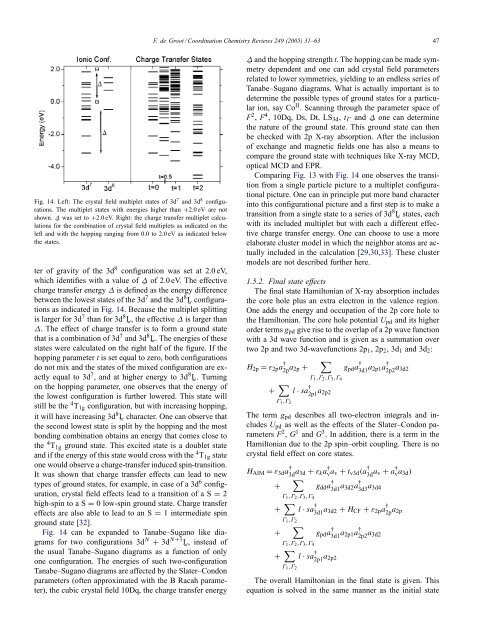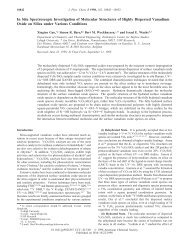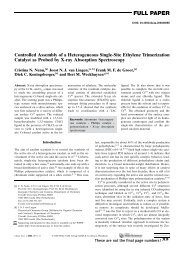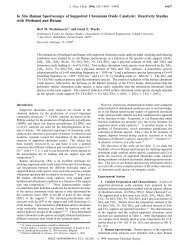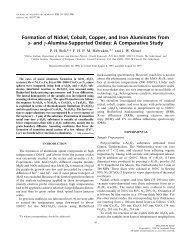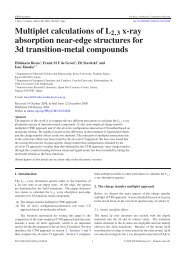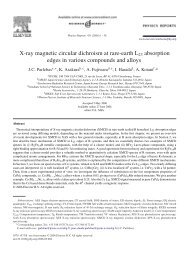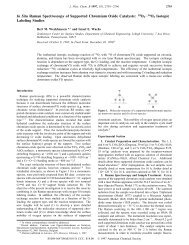46 F. de Groot / Coord<strong>in</strong>ation <strong>Chemistry</strong> Reviews 249 (2005) 31–63spectral shape [31]. The multiplet model approximates theb<strong>and</strong> usually as a square of b<strong>and</strong>width w, where n number ofpo<strong>in</strong>ts of equal <strong>in</strong>tensity are used for the actual calculation.Often one simplifies the calculation further to n = 1, i.e. as<strong>in</strong>gle state represent<strong>in</strong>g the b<strong>and</strong>. In that case the b<strong>and</strong>widthis reduced to zero. In order to simplify the notation we will<strong>in</strong> the follow<strong>in</strong>g remove the k-dependence of the valenceb<strong>and</strong> <strong>and</strong> assume a s<strong>in</strong>gle state describ<strong>in</strong>g the b<strong>and</strong>. It mustbe remembered however that <strong>in</strong> all cases one can changeback this s<strong>in</strong>gle state to a real b<strong>and</strong> with b<strong>and</strong>width w.Remov<strong>in</strong>g the k-dependence renders the Hamiltonian <strong>in</strong>to:Fig. 13. The <strong>in</strong>teraction of a U-correlated localized state with delocalizedb<strong>and</strong>s. From bottom to top are, respectively, given: a general DOS, asemi-elliptical valence b<strong>and</strong>, a square valence b<strong>and</strong> <strong>and</strong> a s<strong>in</strong>gle valencestate.ten as |ψ 0 a † 2p a 3d〉. With second quantization one can also<strong>in</strong>dicate the mix<strong>in</strong>g of configurations <strong>in</strong> the ground state.For example, an electron can hop from the 3d-states toa state <strong>in</strong> the (empty) conduction b<strong>and</strong>, i.e. |ψ 0 a † 3d a ck〉,where a ck <strong>in</strong>dicates an electron <strong>in</strong> the conduction b<strong>and</strong> withreciprocal-space vector k. Comparison to experiment hasshown that the coupl<strong>in</strong>g to the occupied valence b<strong>and</strong> ismore important than the coupl<strong>in</strong>g to the empty conductionb<strong>and</strong>. In other words, the dom<strong>in</strong>ant hopp<strong>in</strong>g is from the valenceb<strong>and</strong> to the 3d-states. If one annihilates an electron <strong>in</strong>a state <strong>and</strong> then re-creates it one effectively is count<strong>in</strong>g theoccupation of that state, i.e. a † 3d a 3d yields n 3d . The Andersonimpurity Hamiltonian can then be given as:H AIM = ε 3d a † 3d a 3d + U dd a † 3d a 3da † 3d a 3d + ∑ k∑+ t v3d (a † 3d a vk + a † vk a 3d)kε vk a † vk a vkThese four terms represent, respectively, the 3d-state, thecorrelation of the 3d-state, the valence b<strong>and</strong> <strong>and</strong> the coupl<strong>in</strong>gof the 3d-states with the valence b<strong>and</strong>. One can furtherextend the Anderson Impurity model to <strong>in</strong>clude more thana s<strong>in</strong>gle impurity, i.e. impurity b<strong>and</strong>s. In addition, one can<strong>in</strong>clude correlation <strong>in</strong> the valence b<strong>and</strong>, use larger clusters,etc. In case of multiplet calculations of X-<strong>ray</strong> absorptionthese approaches lead <strong>in</strong> most cases to a too large calculation.There has been much work for the Cu II case, <strong>in</strong> particular<strong>in</strong> connection to the high Tc superconductors [29], <strong>and</strong>also there have been calculations concern<strong>in</strong>g the effects ofnon-local screen<strong>in</strong>g on larger clusters for Ni II [30].Fig. 13 sketches the Impurity model with a semi-ellipticalb<strong>and</strong> of b<strong>and</strong>width w. Instead of a semi-elliptical b<strong>and</strong> onecan use the actual b<strong>and</strong> structure that is found from DFTcalculations (bottom). It has been demonstrated that theuse of the real b<strong>and</strong> structure <strong>in</strong>stead of an approximatesemi-elliptical or square b<strong>and</strong> structure hardly affects theH AIM−1 = ε 3d a † 3d a 3d + U dd a † 3d a 3da † 3d a 3d + ε k a † v a v+ t v3d (a † 3d a v + a † v a 3d)Br<strong>in</strong>g<strong>in</strong>g the multiplet description <strong>in</strong>to this Hamiltonianimplies that the s<strong>in</strong>gle 3d state is replaced by all states thatare part of the crystal field multiplet Hamiltonian of thatparticular configuration. This implies that the U dd -term isreplaced by a summation over four 3d-wavefunctions 3d 1 ,3d 2 ,3d 3 <strong>and</strong> 3d 4 :H AIM = ε 3d a † 3d a 3d + ε k a † v a v + t v3d (a † 3d a v + a † v a 3d)+ ∑Γ 1 ,Γ 2 ,Γ 3 ,Γ 4g dd a † 3d1 a 3d2a † 3d3 a 3d4+ ∑Γ 1 ,Γ 2l · sa † 3d1 a 3d2 + H CFThe term g dd describes all two-electron <strong>in</strong>tegrals <strong>and</strong><strong>in</strong>cludes the Hubbard U as well as the effects of theSlater–Condon parameters F 2 <strong>and</strong> F 4 . In addition, there isa new term <strong>in</strong> the Hamiltonian due to the 3d sp<strong>in</strong>–orbitcoupl<strong>in</strong>g. H CF describes the effects of the crystal field potentialΦ. This situation can be viewed as a multiplet oflocalized states <strong>in</strong>teract<strong>in</strong>g with the delocalized density ofstates. One <strong>in</strong>gredient is still miss<strong>in</strong>g from this descriptionthat is if the electron is transferred from the valence b<strong>and</strong>to the 3d-b<strong>and</strong>, the occupation of the 3d-b<strong>and</strong> changes byone. This 3d N +1 configuration is aga<strong>in</strong> affected by multipleteffects, exactly like the orig<strong>in</strong>al 3d N configuration.The 3d N +1 configuration conta<strong>in</strong>s a valence b<strong>and</strong> with ahole. Because the model is used ma<strong>in</strong>ly for transition metalcompounds, the valence b<strong>and</strong> is <strong>in</strong> general dom<strong>in</strong>ated bylig<strong>and</strong> character, for example, the oxygen 2p valence b<strong>and</strong><strong>in</strong> case of transition metal oxides. Therefore the hole isconsidered to be on the lig<strong>and</strong> <strong>and</strong> is <strong>in</strong>dicated with L¯, i.e. alig<strong>and</strong> hole. The charge transfer effect on the wave functionis described as 3d N + 3d N+1 L¯. If one <strong>in</strong>cludes the effects ofthe multiplets on the 3d N+1 L¯, a configuration–<strong>in</strong>teractionpicture is obta<strong>in</strong>ed coupl<strong>in</strong>g the two sets of multiplet states.Fig. 14 gives the crystal field multiplets for the 3d 7 <strong>and</strong>3d 8 configurations of Co L¯ II . The 3d 7 configurations is centeredat 0.0 eV <strong>and</strong> the lowest energy state is the 4 T 1g state,where the small splitt<strong>in</strong>gs due to the 3d sp<strong>in</strong>–orbit coupl<strong>in</strong>gwere neglected. The lowest state of the 3d 8 configurationis theL¯ 3 A 2g state, which is the ground state of 3d 8 . The cen-
F. de Groot / Coord<strong>in</strong>ation <strong>Chemistry</strong> Reviews 249 (2005) 31–63 47Fig. 14. Left: The crystal field multiplet states of 3d 7 <strong>and</strong> 3d 8 configurations.The multiplet states with energies higher than +2.0 eV are notshown. ∆¯ was set to +2.0 eV. Right: the charge transfer multiplet calculationsfor the comb<strong>in</strong>ation of crystal field multiplets as <strong>in</strong>dicated on theleft <strong>and</strong> with the hopp<strong>in</strong>g rang<strong>in</strong>g from 0.0 to 2.0 eV as <strong>in</strong>dicated belowthe states.ter of gravity of the 3d 8 configuration was set at 2.0 eV,which identifies with a value of ∆¯ of 2.0 eV. The effectivecharge transfer energy ∆ is def<strong>in</strong>ed as the energy differencebetween the lowest states of the 3d 7 <strong>and</strong> the 3d 8 L¯ configurationsas <strong>in</strong>dicated <strong>in</strong> Fig. 14. Because the multiplet splitt<strong>in</strong>gis larger for 3d 7 than for 3d 8 L¯, the effective ∆ is larger than∆. The effect of charge transfer is to form a ground statethat is a comb<strong>in</strong>ation of 3d 7 <strong>and</strong> 3d 8 L¯. The energies of thesestates were calculated on the right half of the figure. If thehopp<strong>in</strong>g parameter t is set equal to zero, both configurationsdo not mix <strong>and</strong> the states of the mixed configuration are exactlyequal to 3d 7 , <strong>and</strong> at higher energy to 3d 8 L¯. Turn<strong>in</strong>gon the hopp<strong>in</strong>g parameter, one observes that the energy ofthe lowest configuration is further lowered. This state willstill be the 4 T 1g configuration, but with <strong>in</strong>creas<strong>in</strong>g hopp<strong>in</strong>g,it will have <strong>in</strong>creas<strong>in</strong>g 3d 8 L¯ character. One can observe thatthe second lowest state is split by the hopp<strong>in</strong>g <strong>and</strong> the mostbond<strong>in</strong>g comb<strong>in</strong>ation obta<strong>in</strong>s an energy that comes close tothe 4 T 1g ground state. This excited state is a doublet state<strong>and</strong> if the energy of this state would cross with the 4 T 1g stateone would observe a charge-transfer <strong>in</strong>duced sp<strong>in</strong>-transition.It was shown that charge transfer effects can lead to newtypes of ground states, for example, <strong>in</strong> case of a 3d 6 configuration,crystal field effects lead to a transition of a S = 2high-sp<strong>in</strong> to a S = 0 low-sp<strong>in</strong> ground state. Charge transfereffects are also able to lead to an S = 1 <strong>in</strong>termediate sp<strong>in</strong>ground state [32].Fig. 14 can be exp<strong>and</strong>ed to Tanabe–Sugano like diagramsfor two configurations 3d N + 3d N+1 L¯, <strong>in</strong>stead ofthe usual Tanabe–Sugano diagrams as a function of onlyone configuration. The energies of such two-configurationTanabe–Sugano diagrams are affected by the Slater–Condonparameters (often approximated with the B Racah parameter),the cubic crystal field 10Dq, the charge transfer energy∆¯ <strong>and</strong> the hopp<strong>in</strong>g strength t. The hopp<strong>in</strong>g can be made symmetrydependent <strong>and</strong> one can add crystal field parametersrelated to lower symmetries, yield<strong>in</strong>g to an endless series ofTanabe–Sugano diagrams. What is actually important is todeterm<strong>in</strong>e the possible types of ground states for a particularion, say Co II . Scann<strong>in</strong>g through the parameter space ofF 2 , F 4 , 10Dq, Ds, Dt, LS 3d , t Γ <strong>and</strong> ∆¯ one can determ<strong>in</strong>ethe nature of the ground state. This ground state can thenbe checked with 2p X-<strong>ray</strong> absorption. After the <strong>in</strong>clusionof exchange <strong>and</strong> magnetic fields one has also a means tocompare the ground state with techniques like X-<strong>ray</strong> MCD,optical MCD <strong>and</strong> EPR.Compar<strong>in</strong>g Fig. 13 with Fig. 14 one observes the transitionfrom a s<strong>in</strong>gle particle picture to a multiplet configurationalpicture. One can <strong>in</strong> pr<strong>in</strong>ciple put more b<strong>and</strong> character<strong>in</strong>to this configurational picture <strong>and</strong> a first step is to make atransition from a s<strong>in</strong>gle state to a series of 3d 8 L¯ states, eachwith its <strong>in</strong>cluded multiplet but with each a different effectivecharge transfer energy. One can choose to use a moreelaborate cluster model <strong>in</strong> which the neighbor atoms are actually<strong>in</strong>cluded <strong>in</strong> the calculation [29,30,33]. These clustermodels are not described further here.1.5.2. F<strong>in</strong>al state effectsThe f<strong>in</strong>al state Hamiltonian of X-<strong>ray</strong> absorption <strong>in</strong>cludesthe core hole plus an extra electron <strong>in</strong> the valence region.One adds the energy <strong>and</strong> occupation of the 2p core hole tothe Hamiltonian. The core hole potential U pd <strong>and</strong> its higherorder terms g pd give rise to the overlap of a 2p wave functionwith a 3d wave function <strong>and</strong> is given as a summation overtwo 2p <strong>and</strong> two 3d-wavefunctions 2p 1 ,2p 2 ,3d 1 <strong>and</strong> 3d 2 :H 2p = ε 2p a † 2p a 2p +∑g pd a † 3d1 a 2p1a † 2p2 a 3d2Γ 1 ,Γ 2 ,Γ 3 ,Γ 4+ ∑l · sa † 2p1 a 2p2Γ 1 ,Γ 2The term g pd describes all two-electron <strong>in</strong>tegrals <strong>and</strong> <strong>in</strong>cludesU pd as well as the effects of the Slater–Condon parametersF 2 , G 1 <strong>and</strong> G 3 . In addition, there is a term <strong>in</strong> theHamiltonian due to the 2p sp<strong>in</strong>–orbit coupl<strong>in</strong>g. There is nocrystal field effect on core states.H AIM = ε 3d a † 3d a 3d + ε k a † v a v + t v3d (a † 3d a v + a † v a 3d)+ ∑Γ 1 ,Γ 2 ,Γ 3 ,Γ 4g dd a † 3d1 a 3d2a † 3d3 a 3d4+ ∑Γ 1 ,Γ 2l · sa † 3d1 a 3d2 + H CF + ε 2p a † 2p a 2p+ ∑Γ 1 ,Γ 2 ,Γ 3 ,Γ 4g pd a † 3d1 a 2p1a † 2p2 a 3d2+ ∑Γ 1 ,Γ 2l · sa † 2p1 a 2p2The overall Hamiltonian <strong>in</strong> the f<strong>in</strong>al state is given. Thisequation is solved <strong>in</strong> the same manner as the <strong>in</strong>itial state


